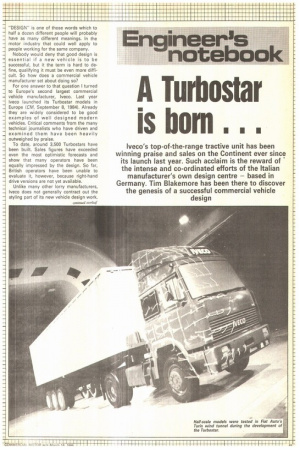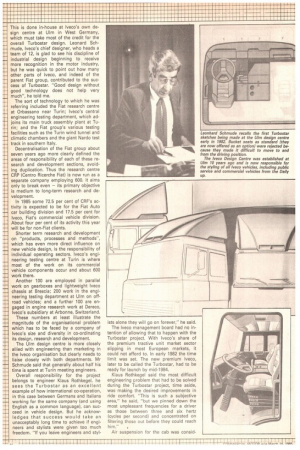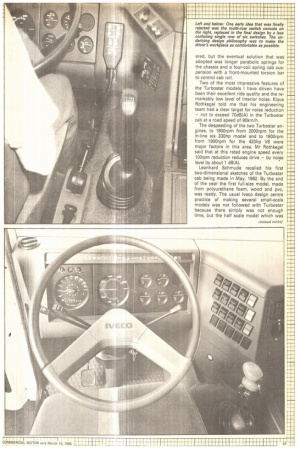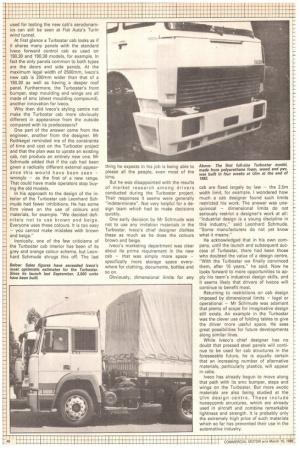A Turbostar is bom
Page 47

Page 48

Page 49

Page 50

If you've noticed an error in this article please click here to report it so we can fix it.
lveco's top-of-the-range tractive unit has been winning praise and sales on the Continent ever since its launch last year. Such acclaim is the reward of • the intense and co-ordinated efforts of the Italian manufacturer's own design centre — based in Germany. Tim Blakemore has been there to discover the genesis of a successful commercial vehicle design
'DESIGN" is one of those words which to half a dozen different people will probably have as many different meanings. In the motor industry that could well apply to people working for the same company.
Nobody would deny that good design is essential if a new vehicle is to be successful, but it the term is hard to define, qualifying it must be even more difficult. So how does a commercial vehicle manufacturer set about doing so?
For one answer to that question I turned to Europe's second largest commercial vehicle manufacturer, Iveco. Last year Iveco launched its Turbostar models in Europe (CM, September 8, 19841. Already they are widely considered to be good examples of well designed modern vehicles. Critical comments from the many technical journalists who have driven and examined them have been heavily outweighed by praise.
To date, around 3,500 Turbostars have been built. Sales figures have exceeded even the most optimistic forecasts and show that many operators have been equally impressed by the design. So far, British operators have been unable to evaluate it, however, because right-hand drive versions are not yet available.
Unlike many other lorry manufacturers, Iveco does not generally contract out the styling part of its new vehicle design work.
• • • • • • •
This is done in-house at Iveco's own design centre at Ulm in West Germany, which must take most of the credit for the overall Turbostar design. Leonard Schmude, Iveco's chief designer, who heads a team of 12, is glad to see his discipline of industrial design beginning to receive more recognition in the motor industry, but he was quick to point out how many other parts of lveco, and indeed of the parent Fiat group, contributed to the success of Turbostar. "Good design without good technology does not help very much", he told me.
The sort of technology to which he was referring included the Fiat research centre at Orbassano near Turin; Iveco's central engineering testing department, which adjoins its main truck assembly plant at Turin; and the Fiat group's various testing facilities such as the Turin wind tunnel and climatic chambers and the giant Nardo test track in southern Italy.
Decentralisation of the Fiat group about seven years ago more clearly defined the areas of responsibility of each of these research and development sections, avoiding duplication. Thus the research centre CRP (Centro Ricerche Fiat) is now run as a separate company employing 600. It aims only to break even — its primary objective is medium to long-term research and development.
In 1985 some 72.5 per cent of CRF's activity is expected to be for the Fiat Auto car building division and 17.5 per cent for lveco, Fiat's commercial vehicle division.
About four per cent of its activity this year -r will be for non-Fiat clients.
Shorter term research and development on "products, processes and methods", which has even more direct influence on new vehicle design, is the responsibility of individual operating sectors. Iveco's engineering testing centre at Turin is where most of the work on its commercial vehicle components occur and about 600 work there.
Another 100 are employed in parallel work on gearboxes and lightweight lveco chassis at Brescia; 200 work in the engineering testing department at Ulm on offroad vehicles; and a further 100 are engaged in engine research work at Dereco, lveco's subsidiary at Arbonne, Switzerland.
These numbers at least illustrate the magnitude of the organisational problem which has to be faced by a company of Iveco's size and diversity in co-ordinating its design, research and development.
The Ulm design centre is more closely allied with engineering than marketing in the Iveco organisation but clearly needs to liaise closely with both departments. Mr Schmude said that generally about half his time is spent at Turin meeting engineers.
Overall responsibility for the project belongs to engineer Klaus Rothkegel. he sees the Turbostar as an excellent example of how international co-operation, in this case between Germans and Italians working for the same company (and using English as a common language), can succeed in vehicle design. But he acknowledges that success would take an unacceptably long time to achieve if engineers and stylists were given too much freedom. "If you leave engineers and styl ists alone they will go on forever," he said.
The lveco management board had no intention of allowing that to happen with the Turbostar project. With Iveco's share of the premium tractive unit market sector slipping in most European markets, it could not afford to. In early 1982 the time limit was set. The new premium lveco, later to be called the Turbostar, had to be ready for launch by mid-1984.
Klaus Rothkegel said the most difficult engineering problem that had to be solved during the Turbostar project, time aside, was making the desired improvements in ride comfort. "This is such a subjective area," he said, "but we pinned down the most unpleasant frequencies for a driver as those between three and six hertz (cycles per second) and concentrated on filtering those out before they could reach
him." ,
Air suspension for the cab was consid ered, but the eventual solution that was adopted was longer parabolic springs for the chassis and a four-coil spring cab suspension with a front-mounted torsion bar to control cab roll.
Two of the most impressive features of the Turbostar models I have driven have been their excellent ride quality and the remarkably low level of interior noise. Klaus Rothkegel told me that his engineering team had a clear target for noise reduction — not to exceed 70dB(A) in the Turbostar cab at a road speed of 80km/h.
The despeeding of the two Turbostar engines, to 1800rpm from 2000rpm for the in-line six 330hp model and to 1800rpm from 1900rpm for the 420hp V8 were major factors in this area. Mr Rothkegel said that at this rated engine speed every 100rpm reduction reduces drive — by noise level by about 1 dB(A).
Leonhard Schmude recalled his first two-dimensional sketches of the Turbostar cab being made in May, 1982. By the end of the year the first full-size model, made from polyurethane foam, wood and pvc, was ready. The usual Ivaco design centre practice of making several small-scale models was not followed with Turbostar because there simply was not enough time, but the half scale model which was used for testing the new cab s aerodynamics can still be seen at Fiat Auto's Turin wind tunnel.
At first glance a Turbostar cab looks as if it shares many panels with the standard lveco forward control cab as used on 190.30 and 190.38 models, for example. In fact the only panels common to both types are the doors and side panels. At the maximum legal width of 2500mm, lveco's new cab is 200mm wider than that of a 190.30 as well as having a deeper roof panel. Furthermore, the Turbostar's front bumper, step moulding and wings are all made of smc (sheet moulding compound), another innovation for lveco.
Why then did lveco's styling centre not make the Turbostar cab more obviously different in appearance from the outside compared with its predecessors?
One part of the answer came from the engineer, another from the designer. Mr Rothkegel reminded me of the constraints of time and cost on the Turbostar project and that the plan was to uprate an existing cab, not produce an entirely new one. Mr Schmude added that if the cab had been given a radically different external appearance this would have been seen — wrongly — as the first of a new range.
That could have made operators stop buying the old models.
In his approach to the design of the in terior of the Turbostar cab Leonhard Schmuds had fewer inhibitions. He has some firm views on the use of colours and materials, for example. "We decided definitely not to use brown and beige. Everyone uses these colours. It is too easy — you cannot make mistakes with brown and beige."
Ironically, one of the few criticisms of the Turbostar cab interior has been of its grey and orange colour scheme, but Leonhard Schmude shrugs this off. The last thing he expects in his job is being able to please all the people, even most of the time.
But he was disappointed with the results of market research among drivers conducted during the Turbostar project. Their responses it seems were generally "indeterminate. Not very helpful for a design team which had to make decisions quickly.
One early decision by Mr Schmude was not to use any imitation materials in the Turbostar. lveco's chief designer dislikes these as much as he does the colours brown and beige.
Iveco's marketing department was clear about its prime requirement in the new cab — that was simply more space — specifically more storage space everywhere for clothing, documents, bottles and so on.
Obviously, dimensional limits for any
cab are fixed largely by law — the 2.5m width limit, for example. I wondered how much a cab designer found such limits restricted his work. The answer was unequivocal — dimensional limits do not seriously restrict a designer's work at all: "Industrial design is a young discipline in this industry," said Leonhard Schmude. "Some manufacturers do not yet know what it means."
He acknowledged that in his own company, until the launch and subsequent success of Turbostar, there had been those who doubted the value of a design centre. "With the Turbostar we finally convinced them, after 10 years," he said. Now he looks forward to more opportunities to apply his team's industrial design skills, and it seems likely that drivers of Ivecos will continue to benefit most.
Returning to restrictions on cab design imposed by dimensional limits — legal or operational — Mr Schmude was adamant that plenty of scope for imaginative design still exists. An example in the Turbostar was the clever use of folding tables to give the driver more useful space. He sees great possibilities for future developments along similar lines.
While lveco's chief designer has no doubt that pressed steel panels will continue to be used for cab structures in the foreseeable future, he is equally certain that an increasing number of alternative materials, particularly plastics, will appear in cabs.
lveco has already begun to move along that path with its smc bumper, steps and wings on the Turbostar. But more exotic materials are also being studied at the Ulm design centre. These include honeycomb structures, which are already used in aircraft and combine remarkable lightness and strength. It is probably only the extremely high price of such materials which so far has prevented their use in the automotive industry.




















































































